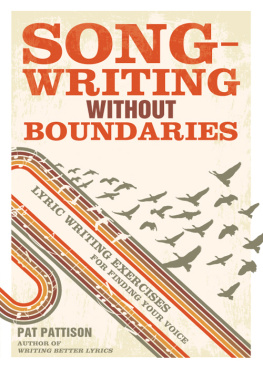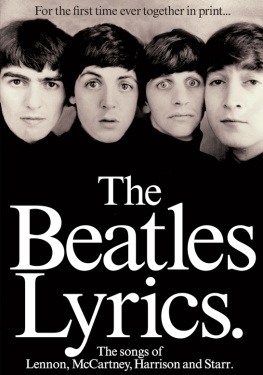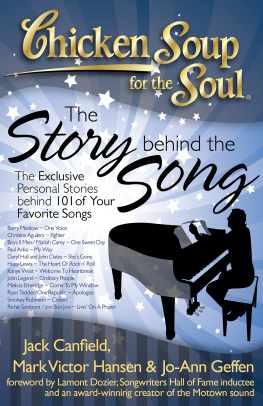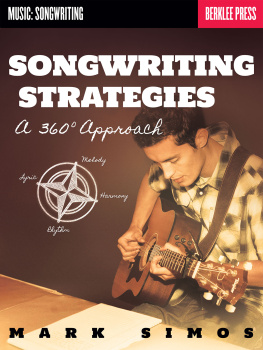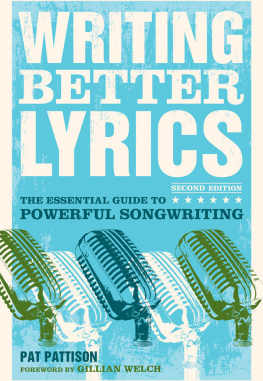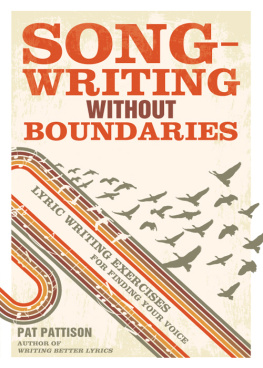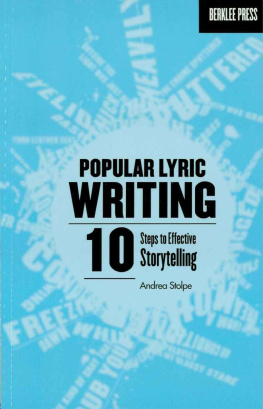WRITING
BETTER
LYRICS
SECOND EDITION
THE ESSENTIAL GUIDE TO * * * * * *
POWERFUL SONGWRITING

PAT PATTISON
FOREWORD BY GILLIAN WELCH
Writing Better Lyrics. 2009 by Pat Pattison. Manufactured in the United States of America. All rights reserved. No other part of this book may be reproduced in any form or by any electronic or mechanical means, including information storage and retrieval systems, without permission in writing from the publisher, except by a reviewer, who may quote brief passages in a review. Published by Writer's Digest Books, an imprint of F+W Media, Inc., 4700 East Galbraith Road, Cincinnati, Ohio 45236. (800) 289-0963. Second edition.
For more resources for writers, visit www.writersdigest.com/books.
To receive a free weekly e-mail newsletter delivering tips and updates about writing and about Writer's Digest products, register directly at http://newsletters.fwpublications.com.
13 12 11 10 09 5 4 3 2 1
Distributed in Canada by Fraser Direct, 100 Armstrong Avenue, George-town, Ontario, Canada L7G 5S4, Tel: (905) 877-4411. Distributed in the U.K. and Europe by David & Charles, Brunel House, Newton Abbot, Devon, TQ12 4PU, England, Tel: (+44) 1626-323200, Fax: (+44) 1626-323319, e-mail: postmaster@davidandcharles.co.uk. Distributed in Australia by Capricorn Link, P.O. Box 704, Windsor, NSW 2756 Australia, Tel: (02) 4577-3555.
Library of Congress Cataloging-in-Publication Data
Pattison, Pat.
Writing better lyrics / by Pat Pattison. 2nd ed.
p. cm.
Includes bibliographical references and index.
ISBN 978-1-58297-577-1 (pbk.: alk. paper)
eISBN 13: 978-1-5996-3365-7
1. Lyric writing (Popular music) I. Title.
MT67.P383 2009
782.421640268 dc22
2009019233

Edited by Scott Francis
Designed by Claudean Wheeler
Production coordinated by Mark Griffin
ABOUT THE AUTHOR
Pat Pattison is a professor at Berklee College of Music, where he teaches lyric writing and poetry. His books include The Essential Guide to Lyric Form and Structure, and The Essential Guide to Rhyming. In addition, Pat has developed three online lyric writing courses for Berklee's online school, and has written articles for a variety of industry publications. His internationally successful students include multiple Grammy winners John Mayer and Gillian Welch. Pat's website is: http://patpattison.com.
THANKS
To my students, especially those who have allowed me to include their work in this book. Their creativity and questions always challenge me, requiring me to look further to make sure I get it right.
To my fellow faculty at Berklee College of Music for trying out these ideas and making them work; for their support, suggestions, and insights.
To the writers and publishers who allowed me to include such excellent material, especially Gillian Welch, Beth Nielsen Chapman, and Janis Ian for their interest and encouragement.
To Mike Reid for his enthusiasm, and for diving into Object Writing with such passion.
To John Mayer, Gillian Welch, Melissa Ferrick, Greg Becker, Kami Lyle, Dave Rawlings, Andrea Stolpe, Scarlet Keys, Ben Romans, Jonelle Vette, Rob Giles, Emily Shackleton, Clare McLeod, and a host of other Berklee transplants to Nashville, New York, Los Angeles, and internationally for showing how well all this stuff can work.
To all the folks that keep showing up for my seminars, allowing me not only to travel the world, but to enlarge my vision in new and interesting ways.
To my son Jason and my daughter Holly Ann. To Mia and Olivia.
I especially want to thank Susan Benjamin for her encouragement, for editing the original articles, and for her comments, focus, and inspiration; in short, for making this book possible.
FOREWORD
I will be brief and not delay with a long introduction, for there is too much good instruction ahead, and there are too many good songs to be written. I know of no other book like this one. One need only follow these tenets and discipline oneself to the task and the songs will come. It is a priceless map through the minefields of clich, boredom, and laziness that often destroy even the best efforts. Sometimes, I think that Writing Better Lyrics is an unfair advantage, a secret weapon of sorts, and yet it is here for any and all who aspire to write and write better. I count myself lucky and proud to have studied with Mr. Pattison. I would not be the writer I am today without his teaching and his unique and comprehensive understanding of language, rhyme, rhythm, and structure. To this day, when I struggle with a lyric and find myself falling short, I am usually ignoring some very sound advice contained in these pages. And I read it again.
Gillian Welch
Nashville, Tennessee
April 2009
INTRODUCTION
I'm very happy that songwriters have found Writing Better Lyrics helpful, and I'm grateful to be writing an introduction to a second edition. It's been a while since the first publication in 1995, and I've learned a lot since then, thanks to my students at Berklee College of Music and the many songwriters I've met and worked with both in my traveling seminars and my online courses. Each time I teach, I learn something new from them a real blessing in my life to be on such a journey.
This edition has added almost one hundred new pages and has INTRODUCTION expanded and revised some of the existing chapters.
I've enlarged the opening chapter on object writing with new (and, I think, more helpful) examples. Over the years, this exercise has proved to be a mainstay for many successful songwriters, including Grammy winners John Mayer and Gillian Welch. The additional material in this chapter incorporates some new and interesting ways to approach object writing, making it an even more useful way to brainstorm, open your senses, and discover unique ideas for your songs.
The chapters on verse development add examples and new material, introducing the concept of boxes, which students over the years have found helpful. I think you will, too.
I've found an interesting and, I hope, helpful way of thinking about rhymes, treating them the way you treat chords in a song. It provides a clearer view of rhyme's function and will help you choose rhyme types for a reason.
The chapters on point of view also have a new look and suggest some interesting ways to approach the process of finding the right perspective for your song.
I've added several new chapters that reflect work I've been doing since the first publication of Writing Better Lyrics. There's a chapter on the productive use of repetition, a chapter on showing and telling, and several in the trenches chapters on structure to help you make more informed decisions while in the heat of writing.
There are two new chapters on handling couplets and common meter. Each will take you through a series of expansions and manipulations of these structures to show you some new options and possibilities, while still keeping to familiar territory.
I've also added a chapter on prosody, the most fundamental principle of songwriting and, indeed, of art in general: the concept that all the elements of a song chords, melody, rhythm, words, and lyric structure should work together for a common purpose.
The centerpiece of this new material is the chapter called Understanding Motion, which explores the intersections of rhythm, rhyme, and phrase length, and their use in creating prosody, which is support for the ideas and emotion of the lyric. Motion creates


